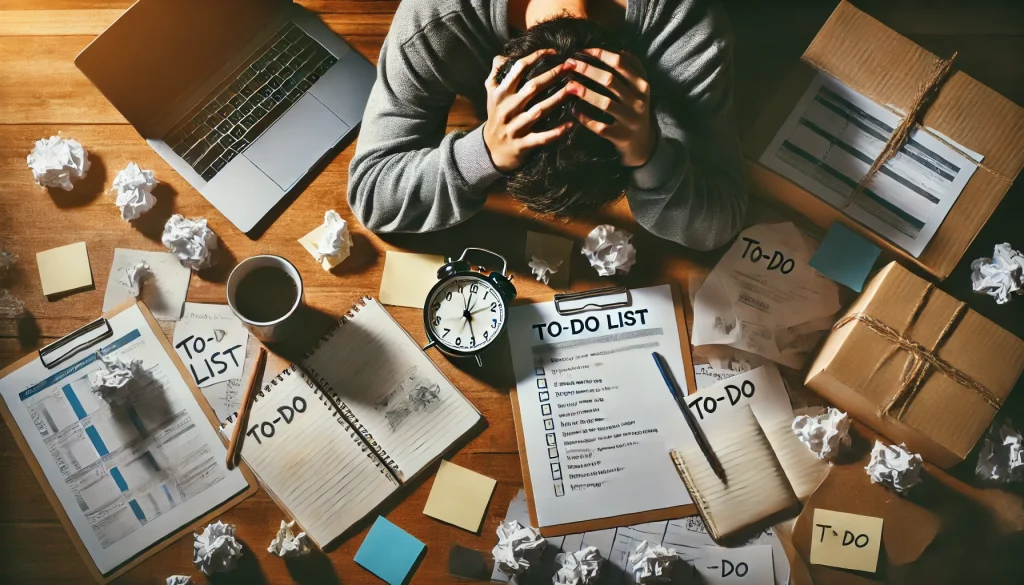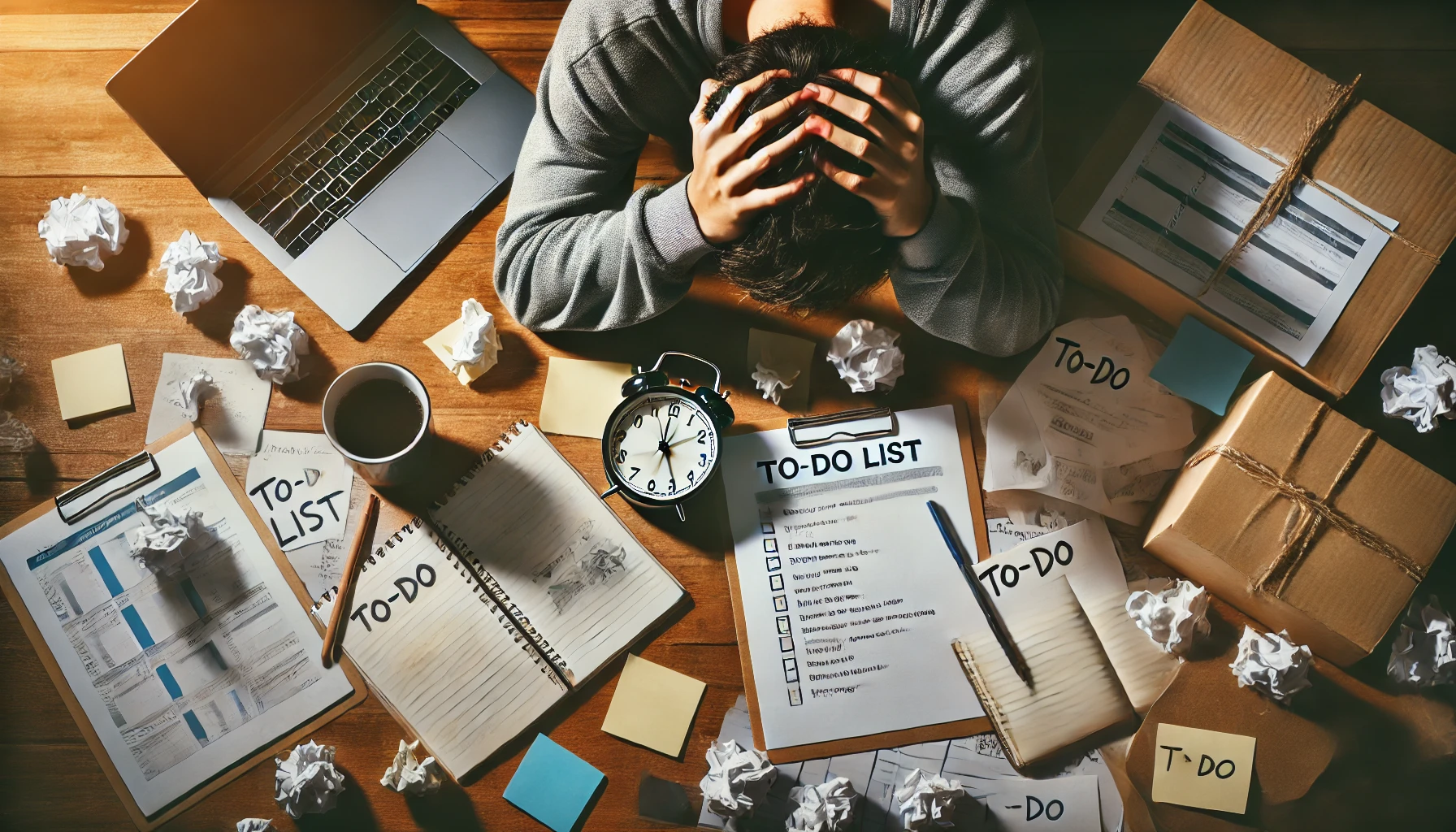Procrastination is the silent productivity killer that keeps millions of people from achieving their full potential. If you’ve ever found yourself stalling instead of tackling important tasks, you’re not alone. It’s time to stop procrastination and take control of your productivity.
Picture this:
It’s Sunday night. You know you have a big project due, important emails to send, or that workout you’ve been putting off. But instead, you’re:
- Binge-watching another Netflix series
- Cleaning your already clean apartment
- Scrolling through social media for the hundredth time
Doing literally anything but the thing you actually need to do. Sound familiar?
If so, it’s time to take the right actions to stop procrastination. The good news is that you can break free from this cycle with a few simple, effective strategies. It won’t happen overnight, but with gradual and consistent effort, you can become the kind of person who takes action now instead of later.

Why Do We Procrastinate?
Before diving into solutions, it’s crucial to understand why we procrastinate in the first place. Procrastination isn’t laziness—it’s often a response to deeper psychological triggers like fear, overwhelm, or lack of structure. We tend to avoid tasks because:
- They feel too overwhelming
- We’re afraid of failing
- We don’t know where to start
- The task seems boring or unpleasant
The problem is, the longer we delay, the worse it gets. There are however proven strategies to stop procrastination and get things done. Let’s dive in.
7 Proven Strategies to Stop Procrastination
1. Break Tasks into Smaller, Manageable Chunks
One of the biggest reasons people procrastinate is feeling overwhelmed. When a task seems too big or complicated, our brain naturally wants to avoid it. Instead, break it down into bite-sized actions so it feels more achievable.
For example:
- Instead of saying”I need to write a report,” say: I’ll start by creating an outline first, then write the introduction, before writing the body.
- Instead of “I need to clean the house,” say, “I will focus on cleaning one room at a time”.
- Instead of “I want to launch a business,” say “I will begin with researching my idea for 15 minutes a day for one week”.
When tasks feel more manageable, they’re easier to start.
Small wins build momentum. The more progress you make, the more motivated you’ll feel to keep going.

2. Use the Two-Minute Rule to Stop Procrastination
If a task takes less than two minutes, do it immediately.
This simple trick prevents small tasks from piling up and becoming overwhelming. Whether it’s:
- Replying to an email
- Making your bed
- Sending that text you’ve been avoiding
- Washing a few dishes
Taking immediate action builds your “productivity muscles” and helps you stop procrastination before it even begins.
3. Implement the Pomodoro Technique
Struggling with focus? Try the Pomodoro Technique, a time management method that keeps your brain engaged without burnout.
Here’s how it works:
Work for 25 minutes intensely
Take a 5-minute break
Repeat this cycle four times
After four cycles, take a longer break (15-30 minutes)
This strategy works because it:
– Prevents mental fatigue
– Trains your brain to focus
– Makes daunting tasks feel manageable

4. Create a Procrastination-Proof Environment
Your workspace directly impacts your productivity. If you’re surrounded by distractions, it’s easier to fall into the procrastination trap.
To stop procrastination, set up an environment that encourages focus:
– Clear your desk – A clutter-free space = a clutter-free mind
– Put your phone on silent or in another room
– Use website blockers – Limit access to distracting sites
– Create a dedicated workspace – Your bed is for sleeping, your desk is for working
By eliminating distractions, you’ll make it easier to get started on tasks instead of delaying them.
5. Set Clear, Realistic Goals
Vague goals = Procrastination.
The solution? Set SMART goals:
Specific – Be clear on what you want to accomplish
Measurable – Define success with numbers or milestones
Achievable – Make it realistic for your current schedule
Relevant – Align it with your bigger goals
Time-bound – Set a deadline
For example:
Instead of “I want to be more productive,” say “I will plan my day every morning by writing down my top three priorities and completing them before 5 PM.”
Instead of “I want to spend less time on social media,” say “I will limit social media to 30 minutes per day using an app blocker.”
Related: Goal-Setting Mastery: How To Set SMART Goals and Actually Achieve Them
6. Practice Self-Compassion
Stop beating yourself up when you procrastinate. It only makes things worse.
Instead, acknowledge that everyone struggles with procrastination—even the most successful people. The difference is, they don’t let one bad day turn into a bad week.
Missed a deadline? Learn from it and move forward.
Fell back into procrastination? Reset and start again.
The goal is progress, not perfection.

7. Utilize Accountability Systems
External accountability can be a powerful motivator to stop procrastination.
Here’s how to create built-in accountability:
Tell a friend or mentor about your goal
Join an accountability group
Use productivity apps to track progress
Write it down – Studies show that people are 42% more likely to achieve goals when they write them down
When someone (or something) is keeping you accountable, you’ll be much less likely to procrastinate.
Bonus Tip: Create A Reward System That Actually Works
Your brain loves rewards. Use this to your advantage!
Finish a project? Treat yourself to a movie night.
Complete a week of no procrastination? Go for a fancy dinner.
Nail a work presentation? Plan a weekend getaway.
By attaching positive reinforcement to productivity, you’ll rewire your brain to take action sooner rather than later.
Conclusion: Progress Over Perfection
Stopping procrastination isn’t about being perfect—it’s about making small, consistent changes that add up over time.
Some days, you’ll crush your to-do list. Other days, you’ll struggle. And that’s okay. What matters is that you keep moving forward.
Your Next Step:
Don’t procrastinate on stopping procrastination!
– Pick ONE technique from this list. Just one.
– Implement it today.
– Let us know in the comments which one you’re starting with!
Procrastination doesn’t define you. Your ability to start, to try, to keep going—that’s what matters.
P.S. Drop a comment below – Which technique do you struggle with the most? Let’s build a community of action-takers!
Related: Procrastination: How To Overcome It And Get Things Done Now.
FREE DOWNLOAD: The 7-Day Success Blueprint Challenge!
Want a structured plan to stop procrastination and boost productivity? Download the FREE 7-Day Success Blueprint Challenge and take action today!
👉 Click here to grab your copy now!



